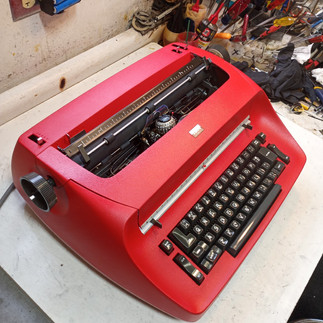The Elusive Red IBM Selectric I
- Impudent Ink
- Feb 6, 2022
- 4 min read
Updated: Feb 16, 2022
Finding an IBM Selectric that appeals to you is difficult. What’s even more difficult is finding an IBM Selectric that actually works.
I was about to give up when my husband and I saw an ad on eBay that showed a pristine pale yellow IBM Selectric I that looked like it had just departed the factory assembly line. I wanted one just like it, but in red (though, yellow would do.)
We wrote to the man who was selling it. That was in early January 2021 and the yellow Selectric wasn’t for sale; it was an example of his work. If I wanted one, it would have to be ordered.
After a few emails back and forth, we called the man who was bringing new life to old Selectrics, machines that had been around for decades, machines that were tossed aside in favour of word processing systems, and those word processing systems tossed aside in favour of personal computers, mobile phones, and tablets.
The man’s name was Charles Furrer and he was in the Chicago area of Illinois. He explained that he finds old Selectrics, repaints them, and completely restores the electric typewriter’s innards using thoroughly cleaned original parts, and/or new components, like the belt, for example.
Sounded very interesting and I already knew what I wanted. It had to be a round-edged Selectric I, in a matte-red most closely resembling IBM’s original colour, with no correcting tape. (See IBM image below)

About a hundred years ago (or thereabouts...) I had used countless Selectrics in offices, before the advent of word processing machines, or even the electronic typewriters I used, like the black, wedge-shaped, Olivetti ET115, hooked up to an ETV 300, or, later, the more modern ETS system. I knew from those early days that I had no interest in the rectangular IBM Selectric IIs or IIIs. They were a bit too modern and rectangular. And I certainly didn’t want some spray painted, garish purple or lime green machine. I wanted a machine that would have been used mainly in the 1960s, or very early 1970s - the Selectric I. I wanted something that would have been in an MCM office next to the Danish-modern teak chairs, the atomic-shaped ashtrays, the red telephones, and grasscloth wallpaper. It had to be as close to the original as possible.
Chuck made a note of what I wanted, but I couldn’t leave anything to chance, so I wrote an email confirming my order’s details. This was an investment, not some random purchase of an IBM off an online marketplace for $50. and finding out too late that it had seized years ago.
Then the weeks dragged on. COVID made certain of that. I spoke to Chuck a couple of times and he said he had the machine, but would need to fulfill orders that had been placed ahead of mine.
I waited.
And then I waited some more.
I think I waited pretty patiently, all things considered. 😉
Then came the email announcing he was just finishing up and he sent a few photos.I marvelled at those photos. I’d never thought that a machine that old could look so new again. I had seen photos of his work, but when I saw the typewriter I had specified taking shape after decades of, well, who knows what, it was marvellous.
These photos were followed by Chuck’s emails telling us he was preparing the machine for shipping. He’s shipped these restored Selectrics around the world, so I was never concerned about his packing methods. Before he began to pack, I asked for a couple of photos now that the machine was totally assembled:
I was shocked at the degree of detail, the perfect IBM matte-red, and the efficiency with which Chuck puts these machines together.
It takes him hours to pack one machine. The Selectric we received could have gone through a tornado and still survived, I assure you. It was bolted and thoroughly padded from every angle. There wasn’t a mark on it, and barely a scratch on the outer box.
We were advised to wait 24 hours to switch it on, and we did. I had images of flicking that rocker switch, something I had done a thousand times in the past, but those were office machines, not my own, made-to-order Selectric. I flicked the rocker to ON and the machine came to life, humming quietly, just as I remembered, when I used them and they actually were brand new machines.
I had three type elements I’d already collected. Chuck had also included a couple of additional type styles. I inserted paper and suddenly it all came back; the familiar clackety-clack, the return key at the end of lines, the gauging of the characters as the bell dinged... 7 characters after the bell rings, I reminded myself.
I had to think about what I was doing. This wasn’t Microsoft Word, nor was it Pages, WordPerfect, DisplayWrite, or the monstrous Xerox 860. It wasn’t even the Olivetti ETS or ETV. This wasn’t even an electronic typewriter. This was mid-century technology, yet it was one of the most complex machines to hit the market and revolutionize offices around the world far quicker than IBM could have even imagined at the time.
So, here is the red Selectric I, completely and professionally restored by Chuck and now in my home office. It resembles a decor piece in this shot, but it's not. I have it on a vintage metal typewriter table that is at the perfect height of 27". It is used regularly, which is advised, as these Selectrics are best when used, not sitting around long enough to gum up.













Comments